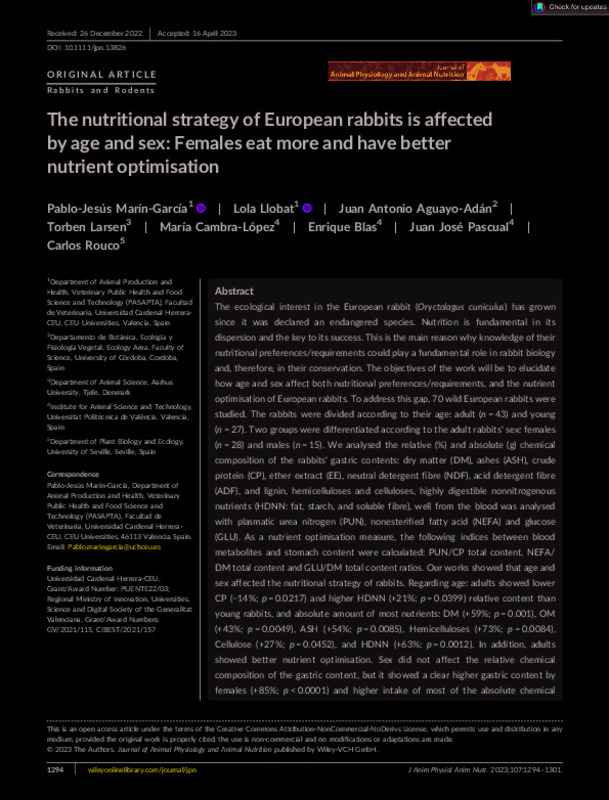JavaScript is disabled for your browser. Some features of this site may not work without it.
Buscar en RiuNet
Listar
Mi cuenta
Estadísticas
Ayuda RiuNet
Admin. UPV
The nutritional strategy of European rabbits is affected by age and sex: Females eat more and have better nutrient optimisation
Mostrar el registro sencillo del ítem
Ficheros en el ítem
| dc.contributor.author | Marín-García, Pablo Jesús
|
es_ES |
| dc.contributor.author | Llobat, Lola
|
es_ES |
| dc.contributor.author | Aguayo-Adán, Juan Antonio
|
es_ES |
| dc.contributor.author | Larsen, Torben
|
es_ES |
| dc.contributor.author | Cambra López, María
|
es_ES |
| dc.contributor.author | Blas Ferrer, Enrique
|
es_ES |
| dc.contributor.author | Pascual Amorós, Juan José
|
es_ES |
| dc.contributor.author | Rouco, Carlos
|
es_ES |
| dc.date.accessioned | 2023-12-26T19:02:49Z | |
| dc.date.available | 2023-12-26T19:02:49Z | |
| dc.date.issued | 2023-09 | es_ES |
| dc.identifier.issn | 0931-2439 | es_ES |
| dc.identifier.uri | http://hdl.handle.net/10251/201124 | |
| dc.description.abstract | [EN] The ecological interest in the European rabbit (Oryctolagus cuniculus) has grown since it was declared an endangered species. Nutrition is fundamental in its dispersion and the key to its success. This is the main reason why knowledge of their nutritional preferences/requirements could play a fundamental role in rabbit biology and, therefore, in their conservation. The objectives of the work will be to elucidate how age and sex affect both nutritional preferences/requirements, and the nutrient optimisation of European rabbits. To address this gap, 70 wild European rabbits were studied. The rabbits were divided according to their age: adult (n = 43) and young (n = 27). Two groups were differentiated according to the adult rabbits' sex: females (n = 28) and males (n = 15). We analysed the relative (%) and absolute (g) chemical composition of the rabbits' gastric contents: dry matter (DM), ashes (ASH), crude protein (CP), ether extract (EE), neutral detergent fibre (NDF), acid detergent fibre (ADF), and lignin, hemicelluloses and celluloses, highly digestible nonnitrogenous nutrients (HDNN: fat, starch, and soluble fibre), well from the blood was analysed with plasmatic urea nitrogen (PUN), nonesterified fatty acid (NEFA) and glucose (GLU). As a nutrient optimisation measure, the following indices between blood metabolites and stomach content were calculated: PUN/CP total content, NEFA/DM total content and GLU/DM total content ratios. Our works showed that age and sex affected the nutritional strategy of rabbits. Regarding age: adults showed lower CP (-14%; p = 0.0217) and higher HDNN (+21%; p = 0.0399) relative content than young rabbits, and absolute amount of most nutrients: DM (+59%; p = 0.001), OM (+43%; p = 0.0049), ASH (+54%; p = 0.0085), Hemicelluloses (+73%; p = 0.0084), Cellulose (+27%; p = 0.0452), and HDNN (+63%; p = 0.0012). In addition, adults showed better nutrient optimisation. Sex did not affect the relative chemical composition of the gastric content, but it showed a clear higher gastric content by females (+85%; p < 0.0001) and higher intake of most of the absolute chemical components: DM (+64%; p < 0.001), CP (+56%; p = 0.0005), OM (+58%; p = 0.0001), ASH (+44%; p = 0.0123), HDNN (+39%; p = 0.001), NDF (+59%; p = 0.001), ADF (+64%; p = 0.0003), lignin (+82%; p = 0.0036) and cellulose (+58%; p = 0.0002). Finally, we observed that females had better nutrient optimisation than males. This works supports the idea that feeding ecology and nutrition are particularly relevant to reproductive success and fitness in wild animals. | es_ES |
| dc.description.sponsorship | Universidad Cardenal Herrera-CEU, Grant/Award Number: PUENTE22/03; Regional Ministry of Innovation, Universities, Science and Digital Society of the Generalitat Valenciana, Grant/Award Numbers: GV/2021/115, CIBEST/2021/157 | es_ES |
| dc.language | Inglés | es_ES |
| dc.publisher | Blackwell Publishing | es_ES |
| dc.relation.ispartof | Journal of Animal Physiology and Animal Nutrition | es_ES |
| dc.rights | Reconocimiento - No comercial - Sin obra derivada (by-nc-nd) | es_ES |
| dc.subject | Dry matter | es_ES |
| dc.subject | Ecology nutrition | es_ES |
| dc.subject | Fitness | es_ES |
| dc.subject | Protein | es_ES |
| dc.subject | Nutrient optimisation | es_ES |
| dc.subject.classification | PRODUCCION ANIMAL | es_ES |
| dc.title | The nutritional strategy of European rabbits is affected by age and sex: Females eat more and have better nutrient optimisation | es_ES |
| dc.type | Artículo | es_ES |
| dc.identifier.doi | 10.1111/jpn.13826 | es_ES |
| dc.relation.projectID | info:eu-repo/grantAgreement/GVA//GV%2F2021%2F115/ | es_ES |
| dc.relation.projectID | info:eu-repo/grantAgreement/GVA//CIBEST%2F2021%2F157/ | es_ES |
| dc.relation.projectID | info:eu-repo/grantAgreement/Universidad CEU Cardenal Herrera//PUENTE22%2F03/ | es_ES |
| dc.rights.accessRights | Abierto | es_ES |
| dc.contributor.affiliation | Universitat Politècnica de València. Escuela Técnica Superior de Ingeniería Agronómica y del Medio Natural - Escola Tècnica Superior d'Enginyeria Agronòmica i del Medi Natural | es_ES |
| dc.contributor.affiliation | Universitat Politècnica de València. Instituto de Ciencia y Tecnología Animal - Institut de Ciència i Tecnologia Animal | es_ES |
| dc.description.bibliographicCitation | Marín-García, PJ.; Llobat, L.; Aguayo-Adán, JA.; Larsen, T.; Cambra López, M.; Blas Ferrer, E.; Pascual Amorós, JJ.... (2023). The nutritional strategy of European rabbits is affected by age and sex: Females eat more and have better nutrient optimisation. Journal of Animal Physiology and Animal Nutrition. 107(5):1294-1301. https://doi.org/10.1111/jpn.13826 | es_ES |
| dc.description.accrualMethod | S | es_ES |
| dc.relation.publisherversion | https://doi.org/10.1111/jpn.13826 | es_ES |
| dc.description.upvformatpinicio | 1294 | es_ES |
| dc.description.upvformatpfin | 1301 | es_ES |
| dc.type.version | info:eu-repo/semantics/publishedVersion | es_ES |
| dc.description.volume | 107 | es_ES |
| dc.description.issue | 5 | es_ES |
| dc.identifier.pmid | 37127906 | es_ES |
| dc.relation.pasarela | S\505909 | es_ES |
| dc.contributor.funder | Generalitat Valenciana | es_ES |
| dc.contributor.funder | Universidad CEU Cardenal Herrera | es_ES |








